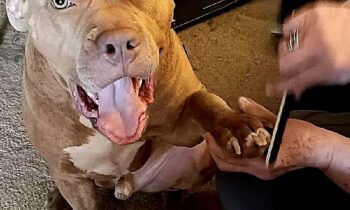
People who have puppies know the value of crates. I rarely meet anyone with a puppy who isn’t using a crate to help with housebreaking and management. Crates have become important equipment for folks with puppies and young dogs.
But what happens to the crate once the dog is housebroken and no longer chews on the furniture? More often than not, the crate is set aside, put away or ignored, stored in case it’s ever needed, even sold at a garage sale.
People forget—crates are for life! I want to persuade you to keep that crate and to use it. Put that crate somewhere in your home where it can stay.
Crates—airline shipping kennels, coated wire kennels, even the most expensive designer indoor kennels—are not what many of us would consider fashionable furniture. In some homes, a crate looks out of place in the living room. In other homes, it fits right in. I’m sure that, no matter your preferences in style and decoration, you can find somewhere in your home for your dog’s indoor kennel, his home inside your home, his crate.
You don’t have to stick to just one place for that kennel, either. Move it around from room to room, so it isn’t the location that makes the dog feel safe and comfy, but the kennel itself. You might even invest in more than one kennel—one in the house, another in the car—so you don’t have to keep switching them out. That can be a hassle, especially with a crate for a big dog. Or maybe it’s easier to have one crate in the basement family room and one in the second-floor bedroom, if those are the two spots where the dog mostly hangs out. (Carrying a kennel up and down several flights of stairs gets old fast!)
You can also vary the style of kennel to suit the season—open coated wire in the summer, so the dog has more air flow and stays cooler, airline kennel in the winter, when the heat his body generates helps him stay warmer in a more enclosed space. A wire kennel with a 360-degree view might be great in the kitchen, keeping the dog out of the way as you prepare meals, while an airline shipping kennel might be more conducive to restful sleep with its small windows and door, closed in and private.

Why would your dog need to be crated as an adult?
Illness or Injury
Very few dogs don’t experience illness or injury at some point in their lifetime.
It can be as minor as a bleeding nail, quicked when you were trimming it. You apply stypic powder or cornstarch, but the nail’s still bleeding a bit, and you don’t want the dog leaving a bloody trail of paw prints all over the house. Put a clean old towel—we call them dog towels—down in the kennel and keep the dog quiet with a frozen KONG or favorite chew until the bleeding’s stopped.
Throwing up is another “illness” that dogs experience often, especially if they eat grass. (You know that’s all it is because your dog does it all the time and you watched him eat the grass.) Today he’s especially vomity. Although you want to stay with him to make sure he’s okay, you don’t want to have to hold him in one place while he’s hurling his grassy guts out! Guide him into the kennel. When he’s recovered, hose out the crate in the yard or throw it in the shower. It’s washable.
Real illness—the kind you take the dog to your veterinary clinic to have diagnosed and treated—may also require crating of the dog. In fact, it may be part of the treatment your vet prescribes. The dog might be too weak to walk around on her own unsupervised or unaided. In the crate, she’s safe while you take a shower, eat a meal, do whatever you need to before you return to check on her. In the crate, you can pile up all the pillows, pad the sides with blankets, and make a comfy nest for your recovering dog to snuggle in. Warm towels from the dryer lend added coziness.
Injured dogs are usually on confinement or “crate rest” for some time as they recover. Re-injury is always an issue. Dogs with incisions might have to remain as physically quiet as possible to avoid popping their stitches. Dogs with amputations may be prohibited from much movement at all. It’s unusual for a dog’s recovery from surgery not to include some time being confined in a kennel.
Age or Infirmity
I have had many dogs who “came back” to the crate when they were seniors. Big dogs with hip dysplasia or arthritis seem to find it easier and more comfortable to stand up and lie down with the support of the sides of an airline shipping kennel. Little dogs like my current senior, five pounds and 15 years old, find the kennel somehow safer than sleeping on the bed. In my dog’s case, I am quite sure that has something to do with her hearing and sight loss. She prefers not to be surprised by something she doesn’t hear or see coming . . . “something” usually being my younger dog, 53 pounds, who tends to step on her if she’s not actively getting out of his way. She currently crates herself at night. If I don’t shut and latch the door right away, she comes to find me to “tuck her in.”
Dogs with loss of balance, permanent or temporary, can’t be left to wander around a several-storey house on their own. You can use heavy-duty baby gates (the kind made for dogs) at the tops and bottoms of your stairs, of course, but that still leaves all sorts of obstacles a dizzy dog could stumble over. It’s certainly safer for the dog to be crated than it is for her to stagger around alone, and many dogs seem to understand that. Get them to one and they’re happy crated.
Dogs with canine cognitive dysfunction (doggy dementia) may also need confinement . . . again for their own good, and also for your peace of mind. When they’re crated, you know they’re safe. They may not know it—they’re no longer capable—but you do, and that helps you both. It’s difficult enough to deal with the long-term care of a cognitively disabled dog, a dog you’ve loved all its life. There’s no sense at all in risking physical injury, or a frightening and incomprehensible situation for the dog, when you have a safe and kind alternative.
Riding in the Car
I know that most people do not confine their dogs in any way in a vehicle. I bet you do, but I don’t think the majority of the rest of the populace does, not in the United States. I hope I’m wrong.
I’m a big proponent of crates in cars. If for whatever reason you can’t use one in your vehicle, at least use the best restraint possible for your size of dog and for your particular vehicle.
Most vehicles have airbags on the passenger side. You cannot let an animal ride there unless you first disable the airbag so that it cannot inflate. Airbags can kill dogs.
It used to be that airline shipping kennels were the safest crates for use in a vehicle, but recently even more indestructible kennels have been invented. These new kennels look very military, like tanks. They are not inexpensive. One of those “Kevlar kennels” might be the most expensive accessory you ever buy for your dog (unless you’re into diamond collars). Do the research, check your budget. You may decide an airline shipping kennel is a good second choice . . . and it is.
I know many people who’ve been in auto accidents, from light collisions to bloody crashes, at low speeds and at high speeds, and I’ve yet to talk to anyone whose dog has been injured seriously. In fact, in more than one of those incidents, the humans in the vehicle—even in seat belts in safe cars—were injured far more than the dog. Kennels approved for airline shipping (not just any “travel” kennel) survive being tossed from a car and landing on the pavement, and often the dogs in them are more frightened than hurt. Another huge plus to crates in vehicles is this: if the crate stays assembled, the dog stays in it.
A dog in a crate is, first and foremost, right there to be dealt with, whether it’s by the dog’s owners in the car or emergency personnel at the scene of the accident.
Otherwise, the dog runs away, if it can. Not a good outcome.
Travel or Visiting
You’re traveling overnight? You’d like to take your dog with you? In your own car, he travels in his crate. When you arrive at your destination —with friends, family, at a motel, hotel, campground—your dog has his own “home away from home” because you take the crate with you to where you’re going to stay. Set it up in your sleeping area and you’re good to go!
You can leave your dog safely confined in your room, as long as he’s not a barker or whiner who might disturb other guests. Housekeeping may unexpectedly open your door. If your dog’s in his kennel, he won’t be able to run out that door.
Until your dog is a frequent traveler, take it easy on him when you take trips together. Don’t be gone from the room for long, give him something to do (like a stuffed KONG) while he’s alone, wear him out as much as possible with activity before you leave him, be sure he’s “empty” before you go. Make sure every trip he’s on is a good experience for him.
It’s exactly the same for overnight stays without his humans, when he goes to stay with friends or family and you head off out of town. With the dog goes his kennel, familiar and safe. Does the dog stay frequently with someone who cares for him when you can’t? Consider getting a crate that remains at that location, so you don’t have to worry about transporting it. The crate at “grandma’s house” soon becomes another familiar safe haven for the dog.
Management
Crating the dog is an alternative to training what’s called a “long stay.”
Let’s say you want to wash the kitchen floor in your open-plan house, which has no doors to close. You could put the dog outside in your fenced yard, most times of the year, anyway. If he’s normally well behaved out there, you can probably get through the washing (if not the drying) before you have to let him in. You could put him in a stay—a “long down”—nearby while you scrub . . . if he’s really flawless at that exercise and if you are prepared to deal with him if he gets up.
But the safest and the kindest choice for your dog while you’re washing—and drying—the kitchen floor is in his kennel with a frozen KONG or a favorite long-lasting chew. You get your floor done. He snacks, then sleeps. No chance of failure, nothing to go wrong. Plus, guaranteed! No doggy footprints across your wet kitchen floor.
Ditto for painting, sanding, wall-papering, plumbing, bathing children, folding laundry—even vacuuming, if he’s a dog who gets shook up by vacuums. You get the idea.
Crate the dog. For his own comfort, for your own convenience.
Have I convinced you that your dog should use his crate every day?
I can’t tell you how many times I ask dog owners if their dog routinely uses a crate. The most frequent answer is, “We used the kennel all the time when she was a puppy being housebroken, but lately . . . ” No, the dog has not been in her crate every day because her crate was put away months ago.
Don’t think you won’t wish, some day in the future, that your dog was more used to the crate.
Don’t think that you won’t ever want to use a crate—even though you currently have no plans to travel, with or without the dog, and there’s no place the dog stays overnight, with you or without you. Even though you have doors on every room, even if you never scrub the kitchen floor.
Don’t think a time won’t come when that crate will mean the difference between “good” and “bad” in the way your dog experiences a situation you can’t avoid.
Stuff happens. Your dog is covered in mud when you’re just about to sit down to dinner. You win an all-expenses-paid cruise on a ship that doesn’t allow pet dogs. You get hit by a bus and your neighbor offers to keep your dog while you recover. Your dog gets sick, your dog gets old. Stuff happens.
Go get that crate out of the closet or basement or wherever you keep it. Put it where your dog can use it, today and every day. You’ll thank me in the long run.



